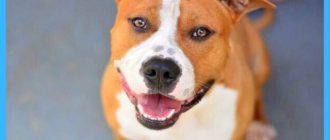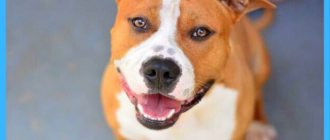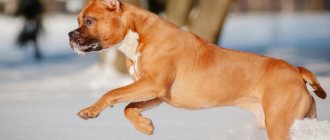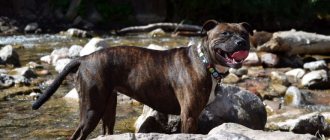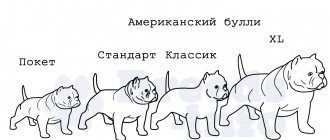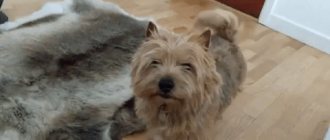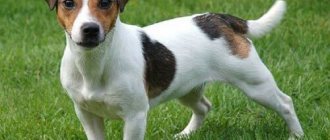Hairless dogs are no longer a rarity, but they are inferior in popularity to their woolly counterparts. Hairless breeds are less common, and some of them, such as the American Hairless Terrier, have not yet been recognized by the International Canine Association. Although in terms of their working and companion qualities they are quite competitive with short-haired and long-haired dogs.
Brief description of the breed
What is the actual country of origin?
USA
What is the country of origin according to the FCI?
—
When did the breed appear?
1972
How long does he live?
from 14 to 16 years old
How much does a male dog weigh?
from 5.5 to 7.3 kg
How much does the bitch weigh?
from 5.5 to 7.3 kg
What is the height (height at withers) of a male dog?
from 30.5 to 40.6 cm
What is the height (height at withers) of the bitch?
from 30.5 to 40.6 cm
How much does a puppy with documents cost?
from 20 to 40 thousand rubles
What is the price of a puppy without documents?
from 5 to 20 thousand rubles
The American Hairless Terrier is one of the most “comfortable” dogs in the world. This is a loyal, intelligent, quick-witted dog that does not require special living conditions or complex care. This terrier, like many other types of terriers, has excellent hunting qualities, an athletic build, and leads an active lifestyle. The American Hairless Terrier can become a true friend and companion.
Types, standards and varieties
These miniature dogs weigh from 3 to 6 kg, and their height at the withers ranges from 25 to 36 cm. In appearance, they take after their ancestors - rat terriers: they have well-developed muscles, a wedge-shaped muzzle, erect or slightly inclined ears, strong shoulders and legs, deep chest. Puppies of this breed are born with soft fur covering their entire body, and they become hairless only at 6-8 weeks. And what a variety of “skin” colors are found in these babies - they are black, and white, and brown and tan, and pink with gray, black or red spots (this color is the most common). The eyes of a dog of this unique breed are also unusual - they are set obliquely and seem to be slightly bulging.
Video
* We invite you to watch a video about the American Hairless Terrier . In fact, in front of you is a playlist in which you can select and watch any of 20 videos about a given dog breed by simply clicking on the button in the upper right corner of the window. In addition, the material contains quite a lot of photos. By looking at them you can find out what an American Hairless Terrier looks like.
In this article:
|
Suitable nicknames
The nickname for AGT should be clear and sonorous. It is undesirable to choose names that begin with a dull sound and contain hissing sounds.
American Hairless Terriers are very active, playful animals that quickly remember sonorous, bright and short names. Long and thorough nicknames, which are usually given to large dogs, will not suit them.
For the female American Hairless Terrier there are the following nicknames:
- Aster;
- Besi;
- Mary;
- Sunny, etc.
For a male dog, you can choose a name from the following list:
- Ben;
- Bruno;
- Deco;
- Jake;
- Jerry;
- Sam, etc.
History of the origin of the American Hairless Terrier
The ancestors of modern American Hairless Terriers are rat-catchers and rat terriers. These dogs first appeared in Britain, where they were used exclusively for working purposes. Terriers made it possible to quickly and effectively get rid of foxes, rats and other small rodents on farms. The ancestors of American Terriers were valued for their working qualities. At that time no attention was paid to the appearance of these animals.
The ancestors of the hairless terrier were brought to America during the process of settling the “New Land”. Terriers appeared there in the eighteenth century. They began to quickly gain popularity. The reason for the great demand for such dogs was again their working qualities. Terriers were excellent at catching and destroying rodents that caused enormous damage to farms and agricultural lands.
Beginning in 1930, the Rat Terrier breed experienced a sharp decline in numbers. The period of the Industrial Revolution led to a decrease in the number of these dogs. Then the farmlands were empty and people no longer needed the services of such a dog. However, some people continued to keep rat terriers, because they were able to discern in them not only excellent working qualities, but also friendliness and a sharp mind.
So, one pair of rat terriers had puppies without hair. This occurred as a result of a genetic mutation. The Scott family especially liked these babies, and they decided to start breeding them. This is how the modern breed appeared: the American Hairless Terrier. In 1990, these dogs were recognized by the Rare Breed organization, but the FCI has still not been able to achieve official recognition of the breed.
American Hairless Terrier - description of the breed
The American Hairless Terrier has a striking appearance:
- developed muscles,
- proportional, athletic build,
- saber tail,
- strong snow-white teeth,
- bare skin.
This pet has small dimensions. The dog grows to a maximum of forty-five centimeters, and its weight rarely exceeds twelve kilograms. This makes the dog very versatile, because it can live both in a spacious private house and in an apartment. Despite its modest dimensions, the animal looks respectable, because it has well-developed muscles and an athletic body shape.
All parts of the American Terrier's body are folded proportionally. The head is medium in size and wedge-shaped. The muzzle is wide, and the neck is quite long and strong. A true Hairless Terrier should have erect ears and protruding eyes. The eyes should be dark in color. The look of such a dog is confident, curious and insightful. The nose may be black or brown.
A special feature of the breed is its beautiful snow-white teeth. The teeth are distributed harmoniously and evenly. The bite can be either straight or scissor. This animal has a “dead” grip. Once in the mouth of a terrier, the prey is unlikely to be able to gain freedom. This allows the dog to still be an excellent rat catcher. The animal's chest is deep, its limbs are strong and muscular.
The paws are small but powerful. These dogs are very agile, which gives their body an athletic shape. They can maintain it until old age. A dog's tail, tapered to the tip. If the animal is tense, the tail takes on a saber shape. At rest it is always pubescent below the level of the back. Dogs of this breed almost always have no hair. The skin is smooth and quite sensitive.
How to choose a puppy
When choosing a hairless terrier puppy, you need to take into account a number of rules and criteria. You should not buy an animal from unverified breeders. It is better to go to a specialized nursery and purchase a dog with a pedigree and official documents confirming its cleanliness.
When looking for a good puppy, you need to make sure that it has white and strong teeth, erect ears and meets the standard. You should also familiarize yourself with the pedigree, the presence or absence of vaccinations and health status.
According to the breed requirements, the pet must have a black or plain nose, dry lips with a tight fit to the muzzle, powerful cheeks and erect or semi-erect ears.
Popular colors of American Hairless Terriers
Today, the gene pool of American Hairless Terriers is gradually expanding by crossing these dogs with dogs of other lines. Therefore, not all American Terriers are completely hairless. Some puppies have fur, but it is very short and dense. If the coat is long or very hard to the touch, then this is considered a defect in the breed. This sign will disqualify the puppy from any show or competition.
Other terriers of this species do not have hair as adults, although up to eight weeks they do have hair, albeit sparsely. Up to two months, the fur is gradually lost. American Terriers have very smooth and soft skin. Always warm to the touch. When frightened, the animal may become completely covered in sweat. American Hairless Terriers come in a wide variety of colors. However, not all of them are in demand.
Preferable are dogs that have one skin color, but have spots of a different color all over the body. The main color of the skin can be any, as well as the size of the spots on the body. This is allowed by the standard. The standard only does not allow albinism, both for the hairless terrier and for the variety with fur. However, you need to know that the terrier's skin color will darken significantly with age. This is due to the dog's exposure to the sun.
Brown, black, and chocolate colors are popular. In second place are shades of apricot and lemon. Terriers with white coats and contrasting heels are also often purchased. Blue skin color is considered unusual. These puppies are also quite popular. However, a very light shade of blue in the color is already a disadvantage of the dog. Blue should be rich and dark.
Character and habits of American Hairless Terriers
American Hairless Terriers are similar in character and habits to other terriers. The only difference is the moderate energy level. The American Terrier is calmer, less lively. But this cannot be called a disadvantage of the breed, because other terriers sometimes exhaust their owners too much. The Hairless Terrier is an obedient, sweet and sociable pet.
This type of terrier is very attached to its family. The puppy will treat every part of it with love and respect. This dog can be friends with people of different ages, especially children. Hairless terriers adore children. They can play with them for hours and are always ready to protect the kids. The American Hairless Terrier should grow up in a family. These dogs cannot stand loneliness, so the owner must have free time.
A feature of the hairless terrier breed is tolerance. These dogs are very kind and patient. They can even tolerate rudeness from children. Terriers are also tolerant of strangers. They will never show aggression without reason. These dogs are friendly and will always try to make friends with strangers or other animals. Their guards are bad, because there is not a drop of aggression in them.
An American Hairless Terrier, with proper training, can live under the same roof with a cat or dog of another breed without problems or conflicts. However, he will not tolerate rodents in his house. This dog should not be left alone with pet hamsters or rats. Hairless terriers have a high level of intelligence. They are sociable and smart. Some representatives of the breed are characterized by stubbornness.
Dog character
High intelligence, curiosity, energy are characteristic of the terrier. They are great companions. They expect attention and love from their owners. Will always strive to earn praise. The dog is active and always open to communication.
Hunting instincts give the dog a fearless character. He will bravely protect the home and family members.
Not prone to aggression. Attacks only in situations of danger. Attentive to the entire family, without exception.
Ready to come to defense at any time. The dog communicates well with children and is ready to babysit them. They are friendly towards other animals.
The Terrier is incredibly devoted and faithful. He is calm, friendly and quick-witted. Always vigilant and protective of the interests of the family.
Note!
Nicknames for dogs for boys - easy, rare and most beautiful names for dogs in alphabetical order
Nicknames for girls' dogs - a list of beautiful, funny, unusual nicknames for large and small dog breeds
Maltipoo dog - everything about the dog from A to Z. Photos, description of the breed, character, maintenance features, prices, reviews
Interesting facts about American Hairless Terriers
- American Hairless Terriers require special attention from the owner in the winter and summer periods of the year. In winter, these animals freeze. They are very sensitive to low temperatures, because hairless terriers have neither a fur coat nor an undercoat. They need warm clothes. In summer, when it is very hot, dogs also suffer. Their skin is sensitive to solar radiation. If your pet stays in the sun for a long time, it can get burned.
- Hairless terriers not only get sunburned, but also develop a tan. Due to the constant exposure of the dog to the sun, the skin begins to darken. Therefore, you need to understand that the puppy’s color will not be the same as at birth all the time. And to prevent the American Hairless Terrier from getting burns, its body must be periodically lubricated with cream. A veterinarian will help you choose the best cosmetics for your pet.
- Few people know that even hairless American terriers have short hair up to a certain age. Until two months their skin is bare. The fur begins to disappear from the age of two weeks. The puppy gradually sheds its hair, and its skin becomes smooth and velvety. At this time, the color of the puppy may also change. For this reason, it is better to buy a dog older than two months.
- Allergy to dog hair is a fairly common disease among people of all ages. This disease deprives a person of the opportunity to find a true friend in the form of a dog. However, the American Hairless Terrier is an exception and this dog is absolutely safe for people with allergies to wool. The hairless terrier has no coat or undercoat. He doesn't shed.
Key points in training
These dogs are very smart and easy to train. They are bred to compete because they trust and obey their owners. But to achieve such a result, the animal must be raised and trained from birth.
The puppy is raised at home from the first days of life. The owner must be strict and firm, but not cruel. Brute force should never be used. The dog can understand intonation. He must understand who is the leader, who to follow and who to listen to. Playing with human things, sleeping on furniture and begging are prohibited.
Vocational training should begin at approximately 3 months of age. It is best to consult with a dog breeder and choose a program that will help the dog and owner understand each other.
For information on how to train a dog, read the article “Training a puppy: effective methods for training trainers, teaching commands at home.”
For animals living in an apartment, the “Dog in the City” training is suitable. It includes not only general socialization, but also a course of basic commands: “sit”, “near”, “voice”, “place”, “no”.
By the age of four to five months, he should know his name and basic commands. If a puppy does not learn this as a puppy, he will be less likely to be well-groomed as an adult.
Pros and cons of American Hairless Terriers
The American Hairless Terrier is a very easy-to-keep pet and this is its main advantage. This is a small dog, so even in a modest one-room apartment it will feel quite comfortable. Of course, subject to daily walks in the fresh air. The Hairless Terrier does not shed, so it does not create clutter in the house. The pet's fur will not lie on furniture or carpets.
The absence of wool is a definite plus for people with allergies. Such a dog can live peacefully in a family where there are people intolerant to dog hair. The advantage of the breed is their good disposition. These dogs are friendly to others and are almost always in a good mood. They are lively, cheerful, but in moderation. You won't be bored with such a pet. He will create a great mood with just his cute appearance.
The advantage of representatives of this breed is their activity. The dog will be able to accompany its owner everywhere: on a bike ride, on a trip to the mountains, during regular walks in the parks. The pet will always follow the owner. The American Terrier has few disadvantages. The main disadvantage of the dog is the lack of protective qualities. These animals lack aggression and physical strength to protect property.
The disadvantage of the breed is the difficulty of skin care. This is due to the fact that dogs do not have hair. Due to the lack of fur, the animal’s skin takes the entire “blow.” In summer it begins to darken under the influence of the sun. Burns often appear on the skin. The terrier's skin needs to be constantly moisturized and protected with creams. In winter, the hairless terrier is very susceptible to cold. These dogs need special clothing.
Breeding American Hairless Terriers
The American Hairless Terrier cannot be called a very popular breed in Russia. However, every year the number of these dogs in our state is growing, because more and more people are considering their positive qualities: ease of maintenance, lack of hair, small size, loyalty and sharp mind. That is why breeding the American Terrier is a pressing issue.
Hairless terriers are bred both among themselves and with some other types of terriers. In order for the mating result to be predictable, it is necessary to breed two hairless terriers. When choosing a mate for a female, you need to take into account a number of criteria. The male must be completely healthy. Any dog’s shortcomings or genetic ailments can be passed on to offspring. The Hairless Terrier must fully meet the standard.
It’s great if the male is a descendant of famous parents. This fact will allow you to set a higher price for puppies. The bitch also needs to be checked by a veterinarian before mating. The female must be ready for childbirth and pregnancy. You shouldn't breed your dog too early. There must be at least two heats. Before the meeting, dogs need to take blood and urine tests. This will ensure that there are no ongoing problems.
It is better to breed American Hairless Terriers indoors, in the dog's territory. There the manufacturer will feel calm, which will have a positive effect on the mating result. There should not be many people in the room. One of the owners is enough. Knitting must be done twice. The second meeting is scheduled no earlier than forty-eight hours after the first. Once pregnant, the bitch will need high-calorie nutrition and vitamins.
Mating
Only sexually mature individuals who have reached 2-2.5 years can be knitted . Girls under this age are physically unable to bear healthy puppies, and boys are unable to conceive. At approximately 8 months, females begin their first estrus .
At the beginning of estrus, the owner of the female must register with the club in order to find a good partner who will complement the girl’s shortcomings. The owners sign certificates and agree on the exact date of the mating. Days 13-15 of the cycle are considered ideal. At this time, the following signs appear: a soft loose loop, light discharge, playful unstable behavior.
On the appointed day, the dogs are brought to neutral territory (or to the male), walked together, or the pets are given 10-20 minutes to get to know each other. When the dog does the cage, you need to help the animals: hold the girl under the belly, and the boy by the lower back. For the first time, you can invite a specialist.
Ideally, if sexual intercourse ends with a lock. But even without it there is a possibility of pregnancy. Repeat mating after 48 hours . It is possible to determine whether a girl is pregnant or not earlier than the 2-3rd week . An ultrasound will show puppies only at 20-25 days ; tests do not give accurate results.
Read a detailed article on the topic: “Everything you need to know about breeding dogs: appropriate age, what to do if it doesn’t work out, rules and tips.”
Caring for American Hairless Terriers
The American Hairless Terrier is a small child. Not in the sense that he will need round-the-clock care, but in the fact that this dog requires affection, care and love from its owners. These are very domestic, loyal pets. They need long walks in the fresh air, intense training and attention from their owner. These simple and straightforward things keep your dog happy and healthy.
However, hairless terriers also need classic hygienic care for:
- skin,
- ears,
- eyes,
- teeth.
The main disadvantage of this dog breed is its hypersensitive skin. It is she who will require a lot of time and attention from people. The skin of this animal in the summer needs to be frequently lubricated with a protective cream, in the winter it needs to be moisturized and protected with dog clothing. American Terriers can become seriously ill and even die due to hypothermia, so you cannot skimp on winter clothing.
Despite the lack of hair, the Hairless Terrier will need bathing. You need to bathe your dog once every two weeks. Paws should be washed daily, after every walk. When bathing, use a gentle cleanser designed specifically for smooth-haired dogs. Bathing should be taught from puppyhood to avoid stress in the sensitive American Terrier.
The animal's ears and eyes should be cleaned with a special lotion once a week or as they become dirty. This will protect the dog from various infections and diseases. You can buy lotion to cleanse these areas at any veterinary pharmacy. A terrier's teeth should be brushed once a week. You should also add solid food to your pet’s daily diet. This will reduce the likelihood of tartar formation.
Diet of American Hairless Terriers
After purchasing a puppy, every person faces the question: what is the best way to feed an American Hairless Terrier? There are three possible feeding methods: natural food, ready-made dog food (dry food), mixed type. Each person should decide which method to choose individually, after consulting with a veterinarian and the breeder from whom the puppy was purchased.
If the first method of feeding was chosen, then you need to competently create a pet menu. The Hairless Terrier's daily diet should largely consist of meat products. You can give your dog lamb, chicken, and some beef. You can supplement the meat with cereals cooked in meat or vegetable broth. Eggs can also be given to a terrier, but only twice a week.
For proper growth and development of the skeleton and muscles, the animal needs dairy products. You can give low-fat cottage cheese, sour cream, fermented baked milk. When choosing to eat natural foods, you should not forget about vitamin supplements. They are required! If you prefer dry food, then vitamin supplements are not needed. These foods contain everything you need. Along with dry food, your pet should be given plenty of water.
Dry food for feeding the American Hairless Terrier must be of high quality. Only premium class products are suitable. Cheaper food can lead to various diseases in your pet. Mixed feeding also takes place. However, such a diet must be correctly calculated and composed. A veterinarian can help with this. When mixed feeding, vitamin supplements may also be required.
Diseases and health problems
The American Hairless Terrier breed was developed relatively recently. It belongs to the group of young breeds. For this reason, there is no accurate information yet on the susceptibility of hairless terriers to certain diseases. At the moment it is known for sure that there are no anomalies or defects in the development of this breed. Severe genetic diseases are practically not diagnosed in puppies.
In this regard, American Hairless Terriers can be bred without the fear of producing sick offspring. Puppies of this breed are distinguished by strong immunity and high vitality. From birth they are active and have an excellent appetite. Hairless terriers rarely get sick from colds if the owner protects the pet from cold and drafts. Representatives of the breed are more prone to:
- Enteritis.
- Gastritis.
- Adenovirus.
To prevent your dog from getting sick with the above ailments, he must have a properly selected diet. It is also important to provide your pet with a daily routine and the optimal amount of physical activity. The owner must be constantly alert. It is important not to miss the first symptoms of diseases, because at the initial stage they are all successfully cured and do not cause much discomfort to the pet.
American Hairless Terriers are also prone to allergies to various factors. The disease can be triggered by medicine, food or even skin care products. Allergy cannot be cured, but its symptoms can be completely eliminated. To do this, you need to eliminate the provoking factor from the puppy’s life. Sunburn is another ailment common to the breed. Hairless terriers should not be in the sun without protection.
Pregnancy and childbirth
Childbirth is an important stage, during which the owner must be nearby and provide assistance.
The average gestation period for this breed is 60–63 days. An ultrasound will help determine when the puppies will appear. This procedure is performed in the first half of pregnancy. You also need to count the days after mating. From the second half of this period, the dog should reduce physical activity and change the method of feeding.
Important! The uterus with fruits takes up a lot of space and puts pressure on the female’s stomach, so she needs fractional feeding.
Before giving birth, the dog begins to behave restlessly, whines, and tries to retire. She needs to prepare a separate place and cover it with a diaper. A cardboard box with a side of 15–20 cm is suitable, on the bottom of which clean cotton pieces of fabric or towels are placed. Make sure that it is not located close to the heating device, as overheating can lead to bleeding in the bitch. But puppies will still need moderate heat, so the best option is to install a lamp over one edge of the box.
The female should also have her temperature measured. A drop in readings to 37–37.5°C indicates impending birth. Puppies will appear within 12-24 hours. During contractions, the dog may have difficulty breathing and vomiting.
The puppy comes out in the membranes, which the female licks off. She also removes secretions from the baby’s mouth and nose so that he can breathe and bites the umbilical cord. This should happen within the next 30 seconds after the cub appears.
Important! The bitch may refuse to perform these procedures if she is whelping for the first time.
Otherwise, the owner must help her. The umbilical cord should be treated with green paint and tied with thread to stop the bleeding. The puppy is then placed on the female's nipple. This will stimulate the birth of the next cub. When the first baby is born, it should be placed in a separate box.
During the birth process, certain difficulties may arise. If you have the following signs, you should immediately contact your veterinarian:
- the puppy does not come out after 30–60 minutes of pushing;
- the baby does not appear within 2 hours after the birth of the previous cub;
- bloody or purulent discharge in the female;
- convulsions, severe trembling of the dog;
- pale gums, decreased temperature;
- the number of placenta does not correspond to the number of puppies.

